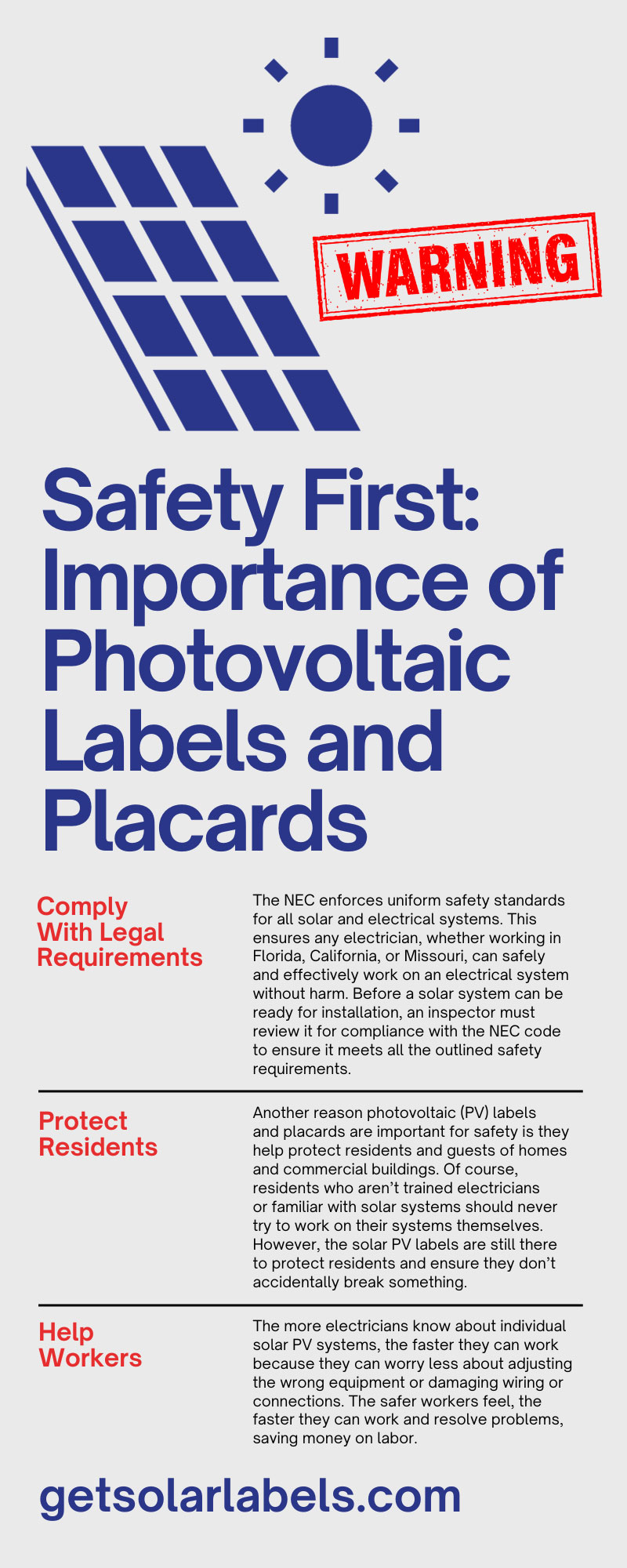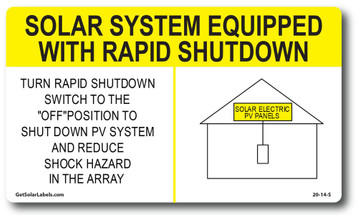Sep 24th 2023
Safety First: Importance of Photovoltaic Labels and Placards
While solar panel systems are different from standard electricity systems for buildings, they still bring the same dangers as any other electrical system. Below, we outline the importance of photovoltaic labels and placards and how they ensure the safety of residents, electricians, and emergency personnel.
Why Your Solar System Needs Solar Labels and Placards
Many practical, safety, and legal reasons exist that govern why every solar system, whether for a residential home or large commercial building, needs warning labels and placards.
Comply With Legal Requirements
To start, a solar panel system for a home or building must have warning labels and safety placards by law. The National Electric Code (NEC), which details safety precautions and measures for all electrical systems, outlines the code solar power systems must follow.
The NEC enforces uniform safety standards for all solar and electrical systems. This ensures any electrician, whether working in Florida, California, or Missouri, can safely and effectively work on an electrical system without harm. Before a solar system can be ready for installation, an inspector must review it for compliance with the NEC code to ensure it meets all the outlined safety requirements.
Protect Residents
Another reason photovoltaic (PV) labels and placards are important for safety is they help protect residents and guests of homes and commercial buildings. Of course, residents who aren’t trained electricians or familiar with solar systems should never try to work on their systems themselves. However, the solar PV labels are still there to protect residents and ensure they don’t accidentally break something.
For instance, if a homeowner is working on other aspects of their house, like the roof, they could injure themselves by accidentally damaging their solar panels’ wiring or connection. Labels help prevent this by warning residents of nearby danger.
Help Workers
A practical benefit of safety warnings and labels for PV systems is they make the job of the maintenance workers and electricians much easier. If the system doesn’t have numerous warning labels and placards pinpointing the location of potentially dangerous elements, workers must be more cautious and conservative with their approach to avoid injury.
The more electricians know about individual solar PV systems, the faster they can work because they can worry less about adjusting the wrong equipment or damaging wiring or connections. The safer workers feel, the faster they can work and resolve problems, saving money on labor.
Safeguard Emergency Personnel
Another reason we have the NEC code for safety protocols is for the safety of emergency personnel like firefighters. If there’s a fire at or nearby a home or building, the electrical system presents an immense danger to the emergency personnel working to extinguish it.
To safely shut down the solar system and ensure damaged or burnt parts don’t electrocute someone, emergency personnel must be able to quickly find the shutdown system. A warning label should clearly mark this shutdown system. Once first responders eliminate the danger of the electrical system, they can work safely to manage the fire without electrocuting themselves or others.
Top Solar PV Safety Hazards
You now know why labels and placards are necessary, but let’s explore the two key dangers they help protect against.
Electrocution
As with any electrical system, whether a standard utility or a solar panel system, electrocution is always the primary concern. In a solar PV system, plenty of current moving through the system could seriously harm workers with an electric shock.
Often, electrocution is due to a short circuit from compromised wiring, improper connections, or insufficient grounding. A solar PV system’s rapid-shutdown switch ensures workers won’t be electrocuted during maintenance or repairs.
Arc Flash Fires
Solar panels, like any electrical system, are also in danger of causing arc flashes. An arc flash is when a flashover of electric current leaves its path and travels through the air to a nearby conductor. Arc flashes are incredibly dangerous because of their intense heat and power. If a person is in the path of an arc flash or close by, they can sustain severe injuries.
Arc flashes, even if they don’t harm someone, are dangerous because they can start fires instantly. Any arc flash’s heat and energy can start a fire if there’s anything flammable in its path, and we all understand how dangerous fires are with electrical circuits and systems.
Labeling Requirements for PV Residential Systems
Now you know why every solar PV system must have the necessary labeling and warning signs for the safety and convenience of the system’s owners, electricians, and emergency personnel. While the specific label requirements for a system depend on factors like the type of system, how much voltage it produces, and where it’s installed, there are some labels that every PV system needs.
PV solar labels must include vital information like the rated maximum power point circuit, the maximum system voltage, the short-circuit current, and more. Plus, solar PV systems must have equipment and components clearly labeled, such as the following parts:
- AC disconnects
- DC junction boxes
- Inverters
- Combiner boxes
- And more
If any of these labels are missing or don’t include the required information, the system is not up to code. This poses a danger to workers and could result in a fine or other penalty for the owner.
Safety Guidelines for PV System Installation and Maintenance
Labels and placards are supplementary security measures that work in tandem with other best safety practices. Below are two of the most important ways workers can stay safe while installing and maintaining clearly labeled PV systems.
Wear Protective Gear
Anyone working on electrical systems, including solar panels, must have the proper safety gear to protect them from dangers like arc flashes and fires. The personal protective equipment (PPE) of an electrician or solar system worker must be flame-resistant (FR) and rated for arc flash safety to ensure it will protect against intense heat and electrical currents.
Along with flame-resistant clothing, solar panel electricians must also have electrical gloves, helmets, goggles, boots, and more to ensure their safety.
Utilize Rapid Shutdown Systems
Since 2014, the NEC has stipulated every PV solar system must include a rapid-shutdown switch. These shutdown systems reduce the voltage within the system in seconds to prevent arc flashes and other dangers while workers attend to it.
If a fire occurs in the building, the rapid-shutdown system ensures no electrical danger from the PV solar system. And as we mentioned, every shutdown system requires clear labeling with a warning sign or placard.
Where To Get Solar Labels and Placards
If you have a solar PV system and need solar labels and warning signs, you’ve come to the right place. Get Solar Labels has all the labels and placards a PV system needs to be safe and up to code. Find the solar label you need for your system in our wide selection online today.


